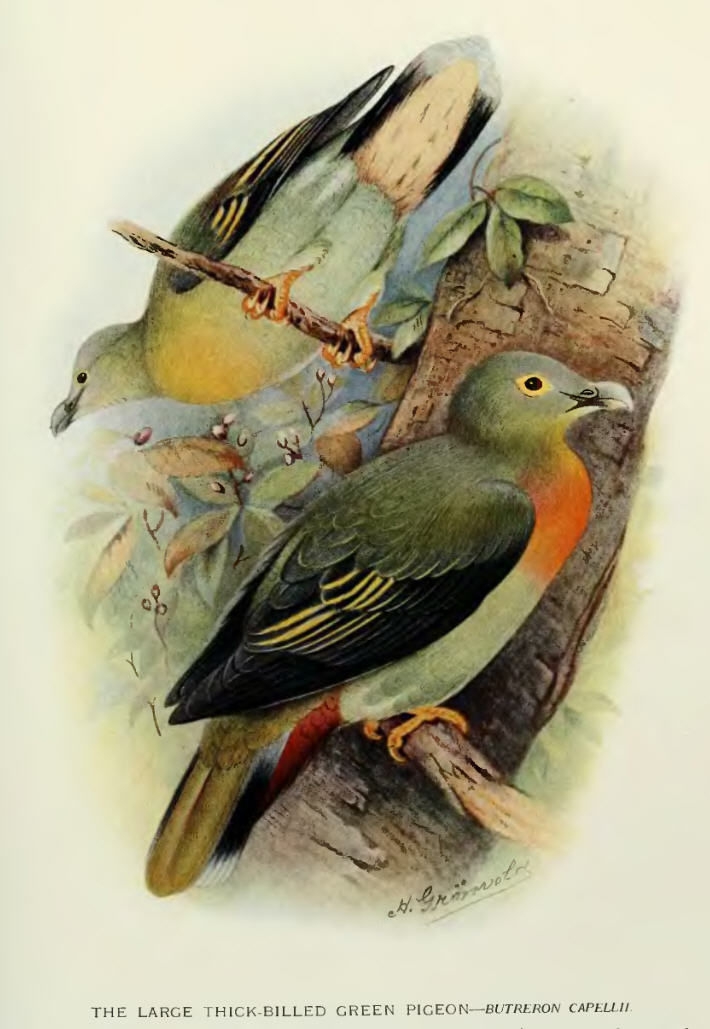| Citation |
|
Description |
Geographic Range [top]
Range Description: Treron capellei occurs from peninsular Thailand and Peninsular Malaysia to Borneo (including Brunei, Sabah and Sarawak, Malaysia, and Kalimantan, Indonesia), and the Indonesian island of Sumatra (BirdLife International 2001). It was once widely distributed and at least locally very common, but serious declines have taken place, such that it is now highly local and scarce. There are no recent records from Myanmar or Java. In the early twentieth century, flocks of 200–300 birds were reported as normal in Peninsular Malaysia (BirdLife International 2001). Regular flocks of 20-30 birds in Taman Negara, and reports that it remains locally common in Belum Temenggor, suggest that sizable populations may still persist within large forest blocks in Malaysia (Yeap Chin Aik in litt. 2007, Iqbal et al. 2012). The species was absent from several recent surveys in Kalimantan (eg. Meier 2005, Brickle et al. 2010, Sheldon et al. 2010), or recorded in small numbers (Slik and Balen 2006, Wielstra and Pieterse 2009, Wielstra et al. 2011, Woxvold and Noske 2011, Wielstra et al. 2012). However, 48 birds were reported roosting on the edge of secondary forest in East Kalimantan in November 2011 and up to 25 were seen at a logging concession in Melawi district, west Kalimantan in March 2011 (Iqbal et al. in press). At least 50 birds were observed inside the Danum Valley conservation area, Sabah in May 2009 (Iqbal et al. 2012). Little is known about its status on Sumatra, however, a flock of more than 40 birds was observed at Way Kambas National Park in May 2006 (Iqbal and Iqbal 2012).
Countries occurrence:
Native:
Brunei Darussalam; Indonesia; Malaysia; Myanmar; Thailand
Additional data:
? Continuing decline in area of occupancy (AOO): Unknown
? Extreme fluctuations in area of occupancy (AOO): No ? Estimated extent of occurrence (EOO) - km2: 3660000
? Continuing decline in extent of occurrence (EOO): Unknown ? Extreme fluctuations in extent of occurrence (EOO): No
? Number of Locations: 11-100 ? Continuing decline in number of locations: Unknown
? Extreme fluctuations in the number of locations: No
? Upper elevation limit (metres): 1500
Range Map: Click here to open the map viewer and explore range.
Population [top]
Population: The population size is preliminarily estimated to fall into the band 10,000-19,999 mature individuals. This equates to 15,000-29,999 individuals in total, rounded here to 15,000-30,000 individuals.
Trend Justification: Rates of forest loss in the Sundaic lowlands have been extremely rapid (Kalimantan lost nearly 25% of its evergreen forest during 1985-1997, and Sumatra lost almost 30% of its 1985 cover), because of a variety of factors, including the escalation of illegal but corruptly promoted logging and land conversion, with deliberate targeting of all remaining stands of valuable timber including those inside protected areas, plus forest fires (particularly in 1997-1998).
Current Population Trend: Decreasing
Additional data:
? Number of mature individuals: 10000-19999 ? Continuing decline of mature individuals: Unknown
? Extreme fluctuations: No ? Population severely fragmented: No
? No. of subpopulations: 2-100 ? Continuing decline in subpopulations: Unknown
? Extreme fluctuations in subpopulations: No ? All individuals in one subpopulation: No
? No. of individuals in largest subpopulation: 1-89
Habitat and Ecology [top]
Habitat and Ecology: It inhabits primary and logged evergreen rainforest, almost exclusively in the lowlands, rarely ascending foothills to 1,500 m. Small flocks visit fruiting trees (usually figs Ficus spp.) and are generally encountered high in the canopy. It is largely sedentary, although populations may fluctuate in response to fruiting cycles, and nocturnal movements have been noted.
Systems: Terrestrial
Continuing decline in area, extent and/or quality of habitat: Unknown
Generation Length (years): 4.2
Movement patterns: Not a Migrant
Threats [top]
Major Threat(s): Massive declines in the population of this species are presumably occurring in the face of habitat loss. Huge areas of lowland forest were removed from its range during the 20th century, chiefly through logging, conversion to agriculture and fire. For example, Kalimantan lost almost 25% of its cover between 1985 and 1997, and Sumatra lost 30% in the same period, suggesting that virtually all original lowland habitat may disappear in the near future, unless preventative measures can be implemented effectively. A similar scenario faces all other range states. Major fires in Borneo and Sumatra continue to affect enormous areas of forest while industrial-scale illegal logging is rampant in almost all "protected" areas. A secondary threat is imposed by widespread high levels of hunting.
Conservation Actions [top]
Conservation Actions: Conservation Actions Underway
It has been recorded in several protected areas, including Taman Negara (Malaysia), Gunung Palung and Tanjung Puting National Parks (Kalimantan), Gunung Leuser and Bukit Barisan Selatan National Parks (Sumatra), and Gunung Mulu (Sarawak).
Conservation Actions Proposed
Conduct comprehensive surveys to establish its current distribution and status, and gather data on its movements and ecological requirements. Formulate a management strategy for Sundaic birds largely reliant on lowland forest. Promote effective management of existing protected areas in the Sundaic region and the expansion of the protected area network. Lobby for reduced logging of lowland forests throughout its range. Establishing High Conservation Forest (HCVF) within plantation areas at remaining forest in Sumatra and Kalimantan are important as buffer zone for its movements.
Citation: BirdLife International. 2016. Treron capellei. The IUCN Red List of Threatened Species 2016: e.T22691198A93305641. http://dx.doi.org/10.2305/IUCN.UK.2016-3.RLTS.T22691198A93305641.en. Downloaded on 02 February 2017.
Disclaimer: To make use of this information, please check the .
Feedback: If you see any errors or have any questions or suggestions on what is shown on this page, please provide us with feedback so that we can correct or extend the information provided
|


